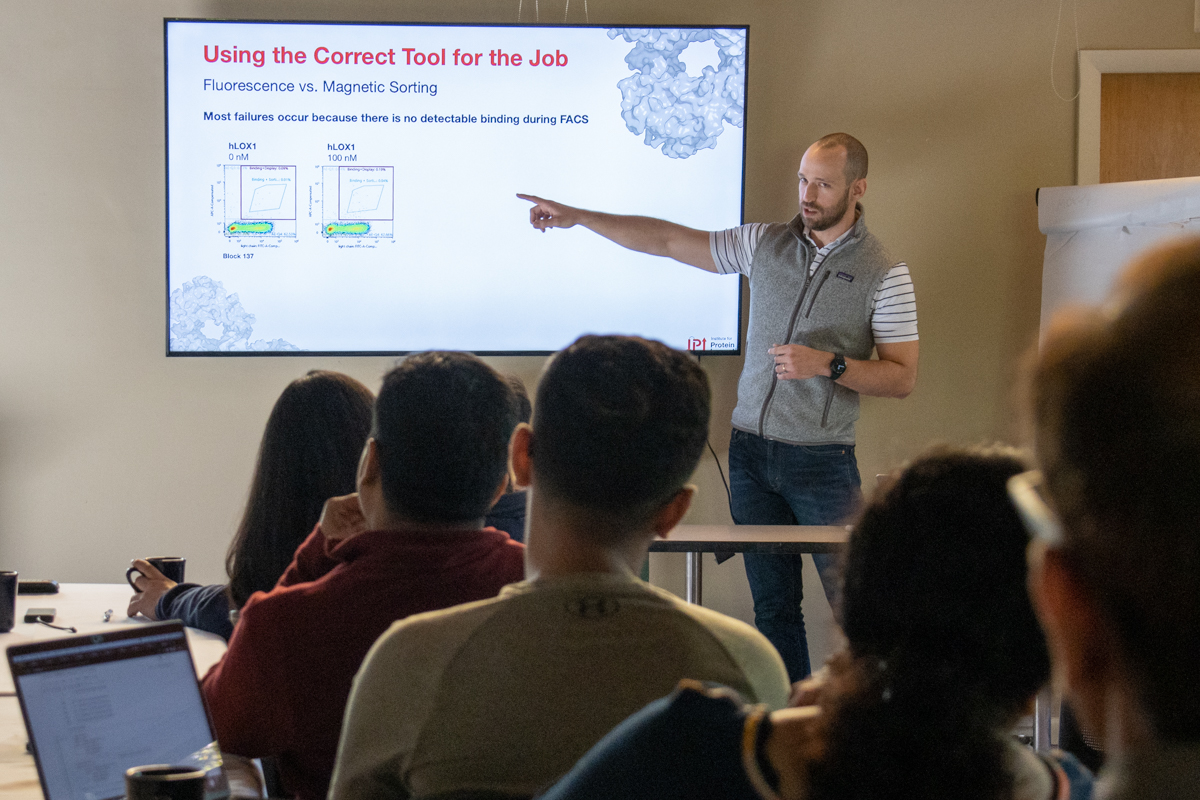It’s a few minutes after noon, and scientists at the Institute for Protein Innovation (IPI) are eating in the conference room. The conversation turns to IPI’s antibody display library — the source material from which the team hunts for antibodies that bind to specific targets. Someone asks: What exactly is the library’s composition? What makes for a good library?
From the kitchen next door, André Teixeira overhears and steps in.
“There’s no one good library,” says Teixeira, IPI’s new director of antibody discovery and library design. “The best library is the one that gives you what you need.”
His comment reflects a hallmark of his scientific style: efficiency. In building a career in protein science and engineering, Teixeira has pursued experimental tools to maximally deliver results for the task at hand. And the tools he knows especially well are protein display libraries.
“André has an encyclopedic knowledge of libraries,” says Rob Meijers, senior director of the Antibody Platform at IPI. “That’s his passion. And that’s exactly what we need.”
Teixeira previously was head of antibody libraries at the antibody engineering company Specifica in Santa Fe, New Mexico, where he improved library technology for antibody drug discovery. Now at IPI, he’s driving advances in antibody library and discovery technologies to deliver high-quality antibodies for biomedical research.
Paths to impact
Teixeira’s fascination with molecular interactions started when he was a child, growing up in São Paulo, Brazil.
Both of his parents — his mother, a psychologist, and his father, a mechanical engineer — imbued everyday life with scientific curiosity. For young Teixeira, the tricky molecular questions his father posed at lunchtime (for example, “Why does ice float on water, if ice and water are made of the same thing?”) were especially appealing.
In high school, a chemistry teacher, who was also a pharmacist, introduced an even more astonishing idea: Every living creature, including a human being, is a combination of molecules and chemical reactions — and one could intervene in those chemical processes, to create desired effects.
Teixeira fixed on that idea: He wanted to find a way to contribute to the discovery and development of drugs.

He started by studying pharmacy at the University of São Paulo — and, while still a student, joined a computational lab modeling protein interactions based on physical chemistry principles. He found that proteins and their surrounding solution were so complex that computing power constrained the size of the systems he could simulate. So he created simplified models that enabled researchers, even with limited resources, to take on bigger systems.
For his Ph.D. research, also at the University of São Paulo, he moved to the wet lab to study Chagas disease, a neglected tropical disease caused by the parasite Trypanosoma cruzi; it primarily affects people in rural communities in Central and South America.
In studying T. cruzi infection, Teixeira set out to understand both sides of the battle: to identify the parasite proteins that recognize human cells, and map the antibodies that the human body generates to retaliate. With thousands of parasite proteins and a nearly infinite antibody response, he again needed a way to manage complexity. He turned to protein display technologies — in which, by engineering phage or yeast to brandish proteins on their surfaces for recognition, scientists can test millions or billions of interactions at once.
In 2016, near the end of his studies, Teixeira visited collaborators at the University of New Mexico. There, he met Andrew Bradbury, who was launching Specifica to build antibody display libraries for discovering therapeutics. Teixeira was enthralled. He returned to Brazil to defend his dissertation, then traveled back to the U.S. to join the company.
At Specifica, Teixeira markedly improved library performance. In particular, the synthetic antibodies derived from libraries often suffered from “liabilities” like instability and indiscriminate binding; before those molecules could become drug leads, they had to undergo extensive engineering. He and the team wanted to obviate the extra, cumbersome steps. So they systematically reengineered every aspect of their libraries — including the antibody scaffold structures, diversity, and liabilities. By maximizing functional diversity and eliminating liabilities, they were able to select antibodies with drug-like properties directly from the libraries, without any further optimization.
Redirecting to research
Over time, Teixeira witnessed antibody discovery technology evolve such that it no longer bottlenecks drug development. Rather, he says, what now limits researchers’ ability to find new treatments is knowledge of the underlying biology.
“There’s only a handful of targets that everyone is working on,” he says. “We need new targets.”
Enabling researchers to unravel biological mechanisms and find new therapeutic targets is exactly the challenge IPI takes on. The Institute aims to generate reagent antibodies for whole families of proteins, including proteins that haven’t been well-studied. That approach paves a route away from well-trodden targets to novel discovery.
The approach also sets up for Teixeira a new design challenge: outfitting antibody engineering to generate fit-for-purpose antibodies at unheard-of scale.
“The usual antibody discovery paradigm,” he explains, is “one high-value target and an entire company devoted to that one molecule.” An antibody discovery operation typically pours time and resources into selecting the best binders and refining candidates through extensive protein engineering.
But at IPI, “We don’t have single targets, we don’t even have a few targets — we have hundreds of targets,” he says. To reach the organization’s mission-driven goals, he says, “we have to be efficient.”
The right tools for the job

To achieve that efficiency, Teixeira and his team at IPI have been interrogating every step in their pipeline — identifying and carefully implementing changes that can achieve the most significant gains. Just several months in, the scientists are seeing substantial increases in successful antibody discovery. Meanwhile, they’re constructing and testing new libraries of antibodies built with different scaffold sequences and variable regions.
His colleague Rob Meijers is thrilled. “Before, it took us a year to make one library,” he says. “Now André is making the next library in one or two months.”
For Teixeira, all this rapid iteration has a clear goal: to create “a plug-and-play” system for antibody discovery. Whatever molecule researchers may need an antibody to target, in whatever assay, he says, “we should know the path to get them that product.”
Sources:
André Teixeira, andre.teixeira@proteininnovation.org;
Rob Meijers, rob.meijers@proteininnovation.org
Writer: Megan Talkington, megan.talkington@proteininnovation.org
About IPI
The Institute for Protein Innovation is pioneering a new approach to scientific discovery and collaboration. As a nonprofit research institute, we provide the biomedical research community with synthetic antibodies and deep protein expertise, empowering scientists to explore fundamental biological processes and pinpoint new targets for therapeutic development. Our mission is to advance protein science to accelerate research and improve human health. For more information, visit proteininnovation.org or follow us on social media, @ipiproteins.


